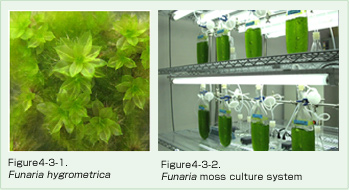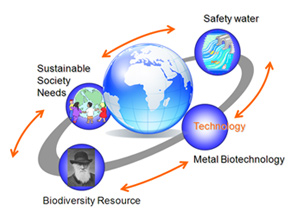
4.Other researches
TOPICS
- 4-1.Carbon and nitrogen balance signaling mediated by plant hormones
- 4-2.Hormone QTL project for the discovery of key genes
- 4-3.Development of environmental conservation and metal-resource recycling technology
4-1.Carbon and nitrogen balance signaling mediated by plant hormones (supported by Scientific Research on Innovative Areas, 2009-2014)
 A comprehensive understanding of high CO2 responses of land plants by a consortium of plant ecologists and molecular biologists
A comprehensive understanding of high CO2 responses of land plants by a consortium of plant ecologists and molecular biologists
Project Leader: Ichiro Terashima, The University of Tokyo
Sakakibara Research Team
PI: Hitoshi Sakakibara
Cooperating researchers: Tomoe Nobusada and Takatoshi Kiba
Research title: Carbon and nitrogen balance signaling mediated by plant hormones
Brief description of the research : Plants have evolved elaborate mechanisms to perceive and respond to environmental stimuli. Phytohormones have been implicated in transmitting the stimuli locally as well as systemically to coordinate morphogenic and metabolic responses. However, little is known about whether and how phytohormones function in high CO2 and high C/N acclimation processes. Hormonome, transcriptome and metabolome analyses of Arabidopsis thaliana and Oryza sativa subjected to high CO2 and high C/N conditions are underway to gather basic information of the acclimation response.
4-2.Hormone QTL project for the discovery of key genes regulating agricultural traits
(supported by National Institute of Agrobiological Sciences, 2008 to 2012)
Cytokinin, auxin, abscisic acid and GA play a central role in regulating plant growth and development. Recent studies have revealed that these plant hormones are also key players in useful agricultural traits, and that human beings have unintentionally utilized natural variations relating to plant hormones for rice bleeding. Hormone concentration is regulated by multiple factors involving signalings and metabolisms. Thus, QTL analysis is a powerful tool to identify key genes regulating plant hormone levels. In this project, we will analyze Backcross Inbred Lines (BIL) and Chromosome Segment Substituted Lines (CSSL) of rice, and try to identify novel useful genes controlling hormone actions for improving agricultural traits
4-3.Development of environmental conservation and metal-resource recycling technology
 Bryophytes diverged around 400 MY ago from land plant ancestors and evolved uniquely. Now we know that some moss species have interesting and useful properties for a sustainable human society. Exploiting their properties, we are trying to develop a bio-sorption system called bryo-filtration. We have found that some bryophytes (eg. Funaria) have the ability to hyper-accumulate heavy metals to unusual levels (1). We are now conducting (i) Development of a massive moss culture system, (ii) Elucidation of a mechanism of hyper-accumulation of heavy metals and rare metals. Our final goal is the establishment of heavy metal and rare metal resource recycling technologies using bryophytes. We also aim to obtain “new” useful mutants for metal recovery by using heavy ion beam irradiation technology. This subject is a joint Research & Development (R&D) program by RIKEN & DOWA Co., LTD.
Bryophytes diverged around 400 MY ago from land plant ancestors and evolved uniquely. Now we know that some moss species have interesting and useful properties for a sustainable human society. Exploiting their properties, we are trying to develop a bio-sorption system called bryo-filtration. We have found that some bryophytes (eg. Funaria) have the ability to hyper-accumulate heavy metals to unusual levels (1). We are now conducting (i) Development of a massive moss culture system, (ii) Elucidation of a mechanism of hyper-accumulation of heavy metals and rare metals. Our final goal is the establishment of heavy metal and rare metal resource recycling technologies using bryophytes. We also aim to obtain “new” useful mutants for metal recovery by using heavy ion beam irradiation technology. This subject is a joint Research & Development (R&D) program by RIKEN & DOWA Co., LTD.
(1) WO/2008/105353. Pb purification method utilizing protonema of moss capable of accumulating Pb therein, and an apparatus for the method.

- Figure4-3-3.
Schematic representation of a sustainable cycle for a safe society utilizing biodiversity and metal biotechnology

